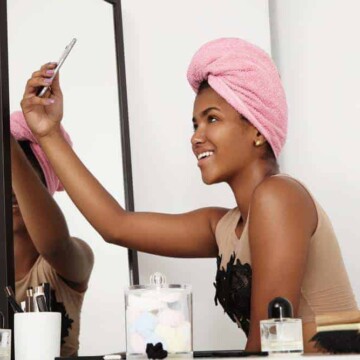
Hair extensions have been around since 3400 B.C. in Ancient Egypt. Today, they blend well with natural hair. These extensions let people change their hairstyles easily. However, removing the glue used to attach them can be hard. If not done right, the glue can damage your hair. This article will show you how to safely remove this glue.
Table of Contents
How to Get Bonding Glue out of Hair
To remove bonding glue from hair, apply oil, peanut butter, or apple cider vinegar. These substances break down the bond of the glue. Gently massage the substance onto the glue spot, then use a wide-toothed comb to remove the glue pieces gently. Finish by washing your hair with a generous amount of shampoo and deep conditioner to replenish moisture.
Key Takeaways
- Removing Bonding Glue. Utilize common household items like peanut butter, apple cider vinegar, or dish soap to dissolve the glue's bond in
hair extensions . These substances break down the adhesive properties of both latex-based and silicone-based glues. - Safe Application. Use a remover, like oil or conditioner, to get the best results on the affected area. Apply it with a cotton swab or clean cloth. Ensure you don't touch your scalp too much to avoid irritation and damage to your hair follicles.
- Comb-Out Process. After applying the remover, use a wide-tooth comb to remove glue from wet hair carefully. This reduces the risk of hair loss and prevents permanent damage from harsh chemicals.
- Deep Conditioning. After removing the glue, wash your hair thoroughly with shampoo. Then, follow up with a deep conditioning treatment. This step is essential. It helps add moisture and nutrients to your hair. This is especially important if you've used acetone or keratin polymer glues.
- Professional Advice. To remove stubborn hair glue, consult hair stylists or use specialized adhesive removers like Ghost Bond Ghost Buster. Professionals can provide tailored solutions based on years of experience and the type of glue used.
How Is Hair Bonding Glue Used?
Bonding glue is used to attach
This bonding glue is exceptionally effective at blending the extensions in with your hair for a natural and seam-free look. It will also hold the extensions securely in place for many weeks and possibly even months at a time.

What Is Bonding Glue Made Of?
Bonding glue is an exceptionally strong material (i.e., strong bond) capable of holding extensions in place for long periods of time and can withstand being washed and brushed.
There are a few different types of hair-bonding glue that are commonly used for weaves or extensions. Some contain latex, which begins as a thick, liquid substance but, when it dries, will turn into a rubber-like consistency.
Other glues are made from keratin polymer. The keratin becomes soft and flexible when heated and then becomes solid again when it cools.
Finally, acrylic hair glue, which is primarily used in fusion weaving, is a solid bonding material that can hold your weave or extension in place for long periods of time.
No matter what type of bonding material has been used in your hair, care should be taken when removing it.

Learn How to Get Hair Glue out of Hair
Within this section, we'll provide step-by-step instructions on how to remove hair extension glue.
The most popular methods used to remove glue from strands include peanut butter, apple cider vinegar, dishwashing soap, oil, conditioner, acetone, and bonding glue removers.
We've also seen some ladies try rubbing alcohol and ice cubes. While these methods may work for you, we've not seen much success from using these methods. Although, I wanted to mention that rubbing alcohol and ice cubes are an option and may work well for you.
It is generally recommended that you seek a professional's help when removing any type of extension from your hair. Bonding materials can be difficult to remove and could cause breakage and damage to your natural hair.
If you are in a pinch and need to remove your extensions yourself, enlist the help of a good friend who can see exactly where the hair glue residue is and will be better able to remove it for you.
Here are the best ways to remove bonding glue from your hair:
1. Peanut Butter
While it may sound strange, using peanut butter to remove sticky substances (like glue and bubblegum) from hair is an old trick that has been used for years.
Peanut butter is an extremely thick substance that contains large amounts of oil. This oil helps to break down the substances in the glue and allows it to be washed out more easily.
Another bonus of using peanut butter is that it is a common substance found in most households, and it is inexpensive to buy.
To try this method:
- Apply a generous amount of peanut butter to the area of your hair that contains the bonding glue.
- Gently massage the peanut butter into the glue with your fingertips. This will help to work the oil in and allow it to work faster and more effectively.
- Cover your hair with a shower cap and let it sit for half an hour.
- Rinse your hair well and add a liberal amount of conditioner.
- Use a detangling comb to brush out any tangles and to remove any remaining remnants of glue.
2. Apple Cider Vinegar
Apple cider vinegar is another common substance that is relatively inexpensive and has proven to be effective at removing bonding glue from hair. The acidity of the vinegar helps to break down the glue and makes it easy to comb out of your hair gently.
To try this method:
- Apply a small amount of apple cider vinegar to the affected areas of the hair.
- Gently massage the apple cider vinegar into the glue and allow it to sit for a few minutes. The vinegar will begin breaking down the bonds in the glue fairly quickly.
- When you feel the glue begin to loosen, use a detangling comb and gently comb the hair glue out. Take care not to brush too hard, and if any glue remains, apply another treatment of apple cider vinegar and repeat the process.
- This process can be repeated as many times as is necessary to remove all of the glue.
- Once you are satisfied that all of the glue has been removed, wash and condition your hair with your favorite shampoo and conditioner.
3. Dish Soap
Dish soap is something that every household has, and it can be an extremely effective method for removing hair glue when you are in a pinch.
Although it may take longer than other methods, the compounds in this product can help break down the glue bonds and help remove the glue from your hair. However, it should also be noted that dish soap can be harsh on your hair, so don’t forget to apply a good conditioner once you're done.
To try this method:
- Soak your hair with plenty of warm water to saturate it fully.
- Apply a liberal amount of dish soap to your hair and take some time to massage it into all of the areas containing glue.
- Using a shower cap or plastic bag, cover your hair and allow the dish soap to sit for forty-five minutes, up to an hour.
- Rinse the dish soap out and use a comb to work out any glue that may still be stuck. Remember, don’t pull too hard, as this may cause damage to your hair.
- When you feel that all of the glue has been removed, use your preferred shampoo and conditioner to clean and moisturize your hair.
4. Hair Oil
Most bonding agents have a natural aversion to any type of oil and will immediately begin losing their bond. The best types of oil to use for this are almond oil, jojoba oil, coconut oil, tea tree oil, or high-quality, extra virgin olive oil.
We don't recommend using regular cooking oil or vegetable oil, but we have seen some women have success with baby oil. Nevertheless, we prefer using hair oils when possible.
To try this method:
- Apply a small amount of the oil of your choice to your fingertips and gently work it into the areas affected by the hair glue.
- Continue to work through your entire head, ensuring that all of the glue has been thoroughly coated in oil.
- Cover your hair with a shower cap and wait for about half an hour.
- The glue will begin to soften to the touch once the oil has started to penetrate it and break down its bonding action.
- Gently comb out the glue once it loosens, taking care not to break or damage your natural hair.
- When you are satisfied that all the glue has been removed, wash and condition your hair. You can use your preferred shampoo and conditioner.
5. Hair Conditioner
If you are stuck with the remnants of bonding glue in your hair, some conditioners can be successfully used as hair bond removers.
This method is easy and relatively inexpensive, depending on the type of conditioner that you choose to use.
Plus, most households already have this product, making it a great solution if you need a quick fix.
To try this method:
- Thoroughly soak your hair in the shower.
- Apply a liberal amount of conditioner to your hair, paying extra attention to the areas most affected by the bonding agent.
- Gently use your fingertips to massage the conditioner into the hair glue, applying more if needed.
- Wrap your hair in a shower cap or grocery bag and allow the conditioner to sit for at least half an hour.
- Rinse the conditioner from your hair.
- Use a wide-tooth or detangling comb to carefully comb through your hair and remove any remaining hair glue.
- When you are satisfied that all of the hair glue has been removed, wash your hair with shampoo and condition your hair again. Special hair products aren't required. You can use your normal shampoo and conditioner.
6. Acetone / Nail Polish Remover
Acetone is perhaps best known as a nail polish remover. Regular nail polish removers are often not pure acetone. So, these won’t be as effective. Be sure if you try this technique to use nail polish remover that is 100% pure acetone.
Nail polish remover can be purchased at most beauty supply stores and is relatively inexpensive.
To try this method:
- Before beginning, make sure that you wear latex gloves. Acetone is a powerful chemical that can cause irritation, so protecting your hands is a must.
- Apply the nail polish remover (i.e., acetone), using a cotton ball, to only the areas affected by the glue. Acetone may dry out your hair, causing it to become brittle and break, so careful application is necessary.
- Allow the nail polish remover to sit for a few minutes. The glue will begin to harden and will lose its sticky, glue-like consistency.
- When the glue becomes hard, use a comb and gently comb out the glue from your hair.
- When you are satisfied that all of the glue has been removed, wash your hair with shampoo and then use an ultra-hydrating conditioner.
7. Bonding Glue Remover (i.e., Hair Glue Remover)
The most popular hair extension brands also make a hair glue remover that is specifically designed to remove glue from your hair strands.
There are also generic brands of hair glue remover that can work effectively with any brand of bonding glue. These products can be purchased at most drug stores, salons, or beauty supply stores.
To try this method, follow the manufacturer’s directions that are included on the packaging. There are several hair glue removers on the market.
However, Big Kizzy Remover and the Salon Pro Super Hair Bond Remover are two that many women have used successfully.
Caring for Your Hair After Removing the Glue

If you're not careful, after removing any type of weft, hair extension, or weave, your hair can be left dull and damaged.
The hair glue that holds these products in place is usually quite strong and can be extremely damaging to the hair. Proper aftercare can ensure that your hair remains healthy and strong.
As we have already mentioned, proper removal of your
Whenever possible, have a salon professional remove your extensions. They will be able to make sure that your natural hair is free from glue and will be able to use the proper products that your extension removal requires.
If going to the salon isn’t possible, then make sure to have someone help you with the extension and hair glue removal process.
A friend will be better able to see all of your
Finally, remember that all of the chemicals and bonding glues that have been used will take a toll on your natural hair, causing drying, split ends, and possibly even breakage.
Make sure that you use a high-quality, deep conditioner after removing the hair glue. This will rehydrate your hair and mitigate breakage in the future.
Frequently Asked Questions
This FAQ section answers common questions about removing bonding glue from
How Do You Get Glue out of Your Hair?
Apply a household remedy like dish soap or conditioner to get glue out of your hair. These can dissolve the glue's bond. Massage it into the affected area, let it sit, then comb out the glue using a wide-tooth comb. Wash your hair thoroughly afterward, using a few tablespoons of shampoo and conditioner to prevent hair loss and damage.
How Do You Get Strong Glue out of Your Hair?
For strong glue, like wig glue or surgical adhesive, consider using an adhesive remover designed for hair systems. Apply the remover to a cotton pad and press it against the glue spot. Let it work for a few minutes to weaken the glue's bond. Then, carefully comb out the glue and wash your hair with shampoo and conditioner.
How Do You Remove Glue From a Hair Unit?
To remove glue from a hair unit, apply a specialized hair adhesive remover or rub a small amount of oil (like argan oil) onto the glued area. Allow it to sit and loosen the bond. Use a narrow-toothed comb to gently remove the remaining glue, taking care not to damage the hair system. Rinse the unit thoroughly with warm water and shampoo.
Can Vaseline Remove Glue From Hair?
Yes, Vaseline can help remove glue from hair. Its oily composition helps break down the adhesive. Apply Vaseline to the glue spot, let it sit for several minutes, then use a comb to remove the glue gently. Wash your hair with shampoo and deep condition afterward to remove any remaining Vaseline and glue.
How Do You Remove Hair Glue With Alcohol?
To remove hair glue with alcohol, specifically isopropyl alcohol, apply it to a cotton pad and dab it onto the glued area. Let it sit for a few minutes to break down the adhesive. Use a wide-tooth comb to remove the softened glue gently. Finish by washing your hair with shampoo and conditioner to remove excess alcohol and prevent dryness.
Long hair looks amazing, and extensions can easily help you achieve a thicker, longer, more voluminous look. Unfortunately, they can also wreak havoc on your hair and leave behind a mess of hair glue.
This hair glue doesn't have to leave you stuck any longer, though! By following the simple steps and tips listed above, you can easily eliminate the remnants of bonding glue and leave your natural hair smooth and healthy once again.




